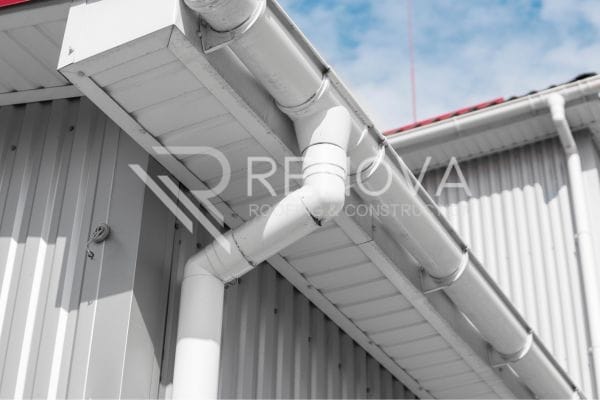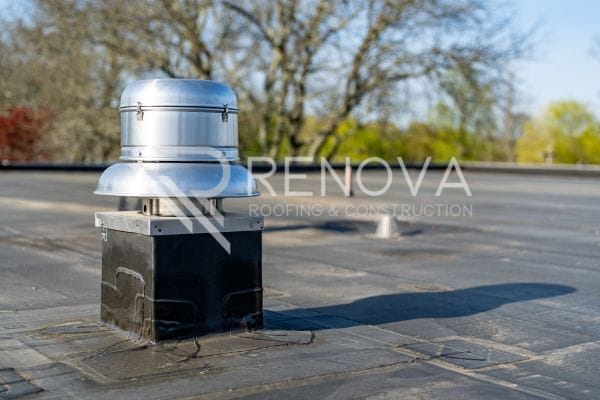Commercial roofs do much more than just keep the weather out. These roofs are characterized by being mostly flat with ow slopes. With this design, it seems like a pretty simple roofing system at the onset. But this is not the case. They are complex structures made up of many different parts that work together to keep the building safe and comfortable. Like a residential roofing system, these roofs also have several components.
As a property owner or a building manager, it is important to invest in a reliable and long-lasting roof, which makes it essential to understand the various components that contribute to its performance and longevity.
In this blog post, we’ll provide a comprehensive explanation of the different parts that make up a commercial roofing system. Understanding the function of each component can help you make better decisions when it comes to maintaining, repairing, or replacing your roof.
Why Should You Learn About The Parts Of A Commercial Roofing System?
Having knowledge about commercial roofs can be extremely helpful in saving you time, money, and headaches in the future. It not only assists you in making informed maintenance decisions, but it also helps you protect against potential problems when evaluating contractor proposals or dealing with repair needs.
By understanding your roof’s anatomy and potential issues that can occur, you can avoid unnecessary expenses caused by replacing parts that could have been easily repaired beforehand.
If you know how your roof works you’ll also be able to ensure that it’s performing at its best, leading to a longer service life and lower costs over time. So, it’s always a good idea to familiarize yourself with the parts of your commercial roofing system and make sure they are in top shape!
What Are The Layers Of A Commercial Roofing System?
A commercial roofing system is more complex than it looks, so let’s explore the different parts of a commercial roof that work efficiently together to form an effective barrier against weather and damage.
Roof Deck: The Foundation
In every construction project, regardless if it’s a skyscraper or a small bungalow the foundation of the building is extremely important, and the same can be said for roofs. The foundation of a durable roofing system is called the roof deck, regardless if it’s a commercial or residential system.
A strong roof deck provides strength and stability to all the other layers that your commercial roofing contractor will install above it. Commercial roof decks are generally made from concrete or steel for enhanced strength as commercial roofs typically have to hold up more weight than residential roofs.
Vapor Barrier
Once the roof deck is installed, it’s time to move on and install the vapor barrier. Most people aren’t aware of how crucial this part of the roof can be, as it’s hidden, but don’t make the mistake of not installing this important layer.
The vapor barrier prevents moisture accumulation within the roofing structure by effectively separating different levels of humidity on either side. Regardless of changes in exterior moisture levels, the interior of the roof will stay fairly dry. This helps you avoid potentially expensive repairs caused by mold and water damage.
Insulation: Keeping Energy Costs Down
As a business owner, energy efficiency is an essential consideration. It not only helps reduce your building’s carbon footprint, but it also leads to significant savings on energy bills. Insulation is a crucial part of the roofing system that combines energy efficiency with protection.
Using insulation is an excellent way to enrich your roofing system with energy-efficient properties. It helps reduce excessive heat gain during summers and heat loss during winters, which can lead to significant savings on energy bills.
Tapered insulation can even be used to adjust the slope of a commercial roofing system in order to enhance drainage.
Roofing Materials
The final layer of a commercial roofing system is the roofing material. This is the most visible layer, the first line of defense for your commercial building, and like with a residential roof, you have several choices available.
However, most commercial roofing options can be categorized into two main groups: roofing membranes or built-up systems. The membrane system involves laying down large sheets of material just as TPO or EPDM, that are welded together to form a waterproof barrier. These are often referred to as single-ply membranes due to only being made with a single layer/roll.
On the other hand, the built-up system integrates layers of bitumen and reinforcement fabrics to create a strong and durable membrane.
These are the layers of a commercial roofing system. However, there are other details that you need to consider.
Additional Components Of A Commercial Roofing System
Adhesive and Fasteners:
These small parts play a critical role in keeping the roofing membrane and other components together and in place. They ensure that the roof is strong enough to withstand extreme weather conditions such as high winds, without tearing away from the roof deck.
Drainage Systems: Drains, Scuppers, and Gutters

An efficient drainage system is crucial to managing rainwater effectively, mitigating potential water damage to the interior and exterior walls. Commercial roofing contractors typically use drains, scuppers, and gutters diligently to divert excess water away from the building’s structure.
Also Read: How Much Does Seamless Gutters Cost?
Flashing

Roof flashing is a critical component in commercial roofing systems, serving as a line of defense against water infiltration along vulnerable areas like roof edges, chimneys, and vents. Flashing is strategically installed along these areas and intersections to create a watertight seal, and are typically made of metal or rubberized asphalt.
Roof Accessories: Vents, HVAC Units, and Skylights
While the main components of a commercial roofing system provide the foundation for a durable and weatherproof structure, various accessories play crucial roles in enhancing both the functionality and appearance of the roof.
Roof Vents

Proper ventilation is vital for maintaining a healthy interior environment and preventing moisture buildup, which can lead to structural damage or mold growth. Vents, such as box vents or turbine vents are strategically placed on the roof to enhance airflow throughout the roofing system.
HVAC Systems

Heating, ventilation, and air conditioning (HVAC) units are essential for maintaining comfortable indoor temperatures and air quality in commercial buildings. Since it is a commercial building, it’s easier to utilize larger HVAC systems with the extreme surface area on the roof.
Skylights

Skylights are not only functional components but also architectural elements that can enhance the aesthetic appeal of a commercial building. Though these are not present on every roof, their presence is increasing in commercial spaces, thanks to their benefits.
Also Read: All About Commercial Roof Coatings
Conclusion
When you’re making decisions for your commercial building, we hope this information will help you. Not only will this information make navigating any roofing process a little easier, but it will also help you develop comprehensive knowledge about cost factors and maintenance needs.
All this can help you to make informed choices for your commercial building.
Understanding the technical talk can initially feel like navigating a maze. However, with this simplified description of the diverse parts that make up a commercial roofing system and their significance, we hope you are now in a much better position going further.
Trust The Best Roof Installers In Mississippi
Commercial roof installation is much different from residential roof installation. This is why if you are thinking about installing or replacing your roof, you want to hire experts who have the necessary experience in commercial and industrial roofing, such as the team at Renova Roofing & Construction.
We are premier commercial flat roofing contractors serving Mississippi, Alabama, and Louisiana. Our services include:
Contact us today at (601) 647-3433 to learn more about us and the services we offer.

